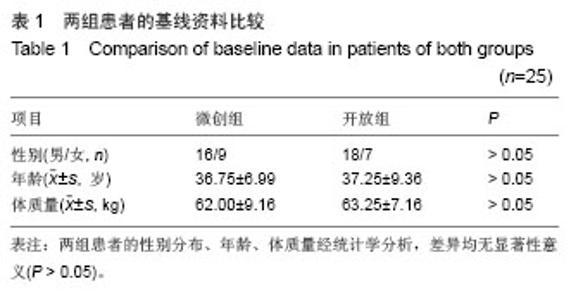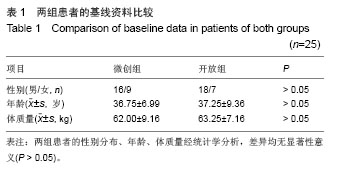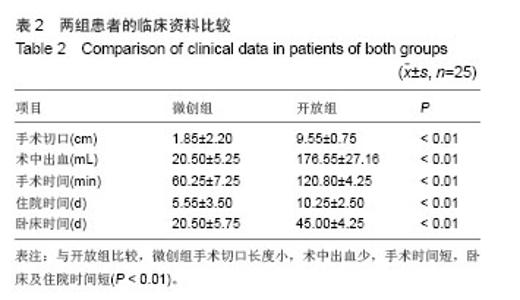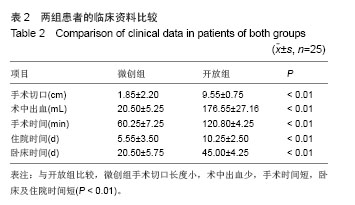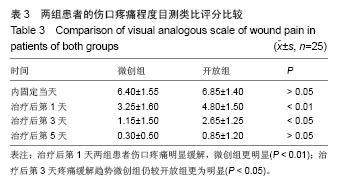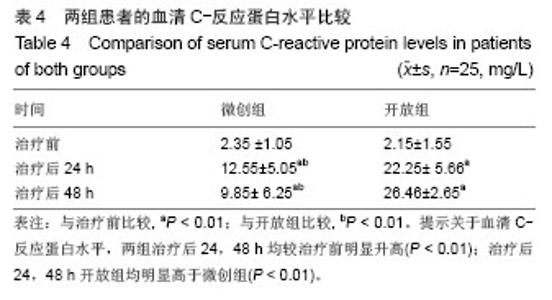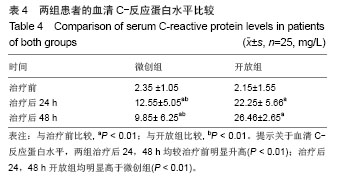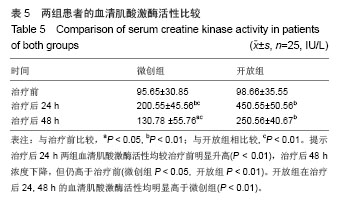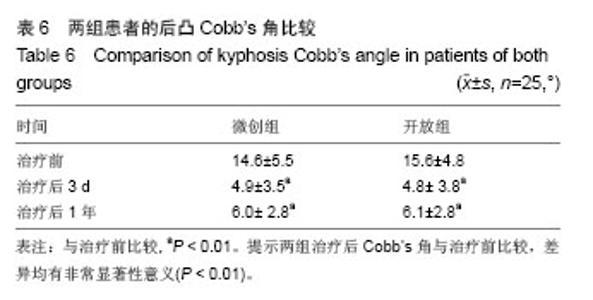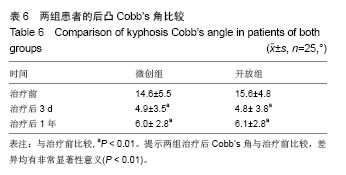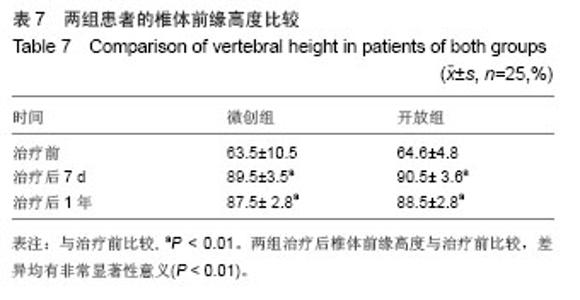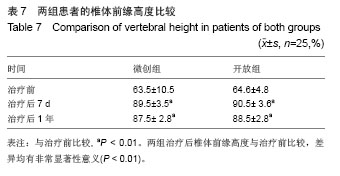Chinese Journal of Tissue Engineering Research ›› 2014, Vol. 18 ›› Issue (44): 7094-7099.doi: 10.3969/j.issn.2095-4344.2014.44.008
Previous Articles Next Articles
Minimally invasive percutaneous pedicle screw fixation versus open surgery for thoracolumbar fracture: Cobb’s angle and vertebral height
Nie Feng-feng, Zhang Ying-hua, Huang Shou-guo, Ju Liang, Chen Bo
- Department of Orthopedic Spine, Linyi Municipal Yishui Central Hospital, Yishui County 276400, Shandong Province, China
-
Online:2014-10-22Published:2014-10-22 -
Contact:Zhang Ying-hua, Chief physician, Department of Orthopedic Spine, Linyi Municipal Yishui Central Hospital, Yishui County 276400, Shandong Province, China -
About author:Nie Feng-feng, Master, Attending physician, Department of Orthopedic Spine, Linyi Municipal Yishui Central Hospital, Yishui County 276400, Shandong Province, China
CLC Number:
Cite this article
Nie Feng-feng, Zhang Ying-hua, Huang Shou-guo, Ju Liang, Chen Bo. Minimally invasive percutaneous pedicle screw fixation versus open surgery for thoracolumbar fracture: Cobb’s angle and vertebral height[J]. Chinese Journal of Tissue Engineering Research, 2014, 18(44): 7094-7099.
share this article
| [1]池永龙,徐华梓,林众,等.微创经皮穿刺椎弓根螺钉内固定治疗胸腰椎骨折的初步报道[J]. 中华外科杂志,2004,42(24): 1307-1311.
[2]Kim DY,Lee SH, chung SK,et al.Compation of multifidus muscle atrophy and trunk extension muscle Strength :Percutaneos versue open Pedicle Scren fixation. Spine. 2005;30(1):123-129.
[3]林章旺,张毅,孔祥亮,等.经皮椎弓根钉内固定术治疗胸腰椎骨折[J].中国伤残医学,2012,20(10):45-46.
[4]Stevens KJ, Spenciner DB, Griffiths KL,et al.Comparison of minimally invasive and conventional open posterolateral lumbar fusion using magnetic resonance imaging and retraction pressure studies. J Spinal Disionrd Tech. 2006; 19(2): 77-86.
[5]Palmisani M,Gasbarrini A,Brodano GB,et al. Minimally invasive percutaneous fixation in the treatment of thoracic and lunbar spin fractures. Eur Spine J. 2009;18(1):71-74.
[6]Magerl F. External skeletal fixation of the lower thoracic and the lumbar spine. In:Unthoff HK,Stahl E.Current concepts of external fixation of fractuers. New York:Spring Verlag, 1982: 353-366.
[7]Ni WF, Huang YX, Chi YL,et al.Percutaneous pedicle screw fixation for neurological intact thoracolumbar burst fractures. J Spinal Disord Tech. 2010;23(8) :530-537.
[8]刘军,项良碧,陈语,等."触摸法"经皮椎弓根钉内固定治疗不稳定胸腰椎骨折[J].颈腰痛杂志,2010,31 (5):330-334.
[9]Palmisani M, Gasbarrini A, Brodano GB, et al. Minlmally invasive percutaneous fixtion in the treatment of thoracic and lumbar spinefractures. Eur Spine J. 2009;18 Suppl 1:71-74. doi: 10.1007/s00586-009-0989-6.
[10]Gaines RW Jr. The use of pedicle -screw internal fixtion for the operative treatment of spinal disorders. J Bone Joint Surg Am. 2000;82(10):1458-1476.
[11]池永龙,王向阳.经皮与开放椎弓根螺钉固定治疗胸腰椎骨折的比较研究[J].中华外科杂志,2008,46(2):112-114.
[12]Dick W, Kluger P, Magerl F, et al. A new device for interal fixation of thoracolumbar and lumbar spin fratures: the firateur in terne. Paraplegia. 1985;23(4):225-232.
[13]Mathews HH,Long BH. Endoscopy assisted percutane-ous anterior interbody fusion with subbcutaneous suprafascial intenal fixation:evolution of technique and surgical consideration.Orthop Int Ed. 1995;3:456:500.
[14]李长青,罗刚,周跃,等.新型微创经皮椎弓根螺钉内固定治疗胸腰椎骨折[J].中华创伤杂志,2009,25(6):522-525.
[15]王洪伟,李长青,周跃,等.附加伤椎固定的微创经皮椎弓根螺钉(Sextant)治疗胸腰椎骨折[J].中华创伤骨科杂志,2010,12(2): 126-130.
[16]王洪伟,李长青,周跃,等.微创与传统开放附加伤椎经椎弓根螺钉内固定手术治疗胸腰椎骨折的疗效比较[J].中国脊柱脊髓杂志,2010,20(2):112-116.
[17]刘曙光,杜贾军,孟龙.手辅助胸腔镜食管癌切除术与传统术式围术期血清IL-6水平的对比观察[J].山东医药,2005,45(27):23-24.
[18]Ruzic B,Tomaskovic I,Trnski D, et al. Systemic stress responses in patients undergoing surgery for benign prostatic hyperplasia. BJU Int.2005;95(1):77-80.
[19]Buunen M, Gholghesaei M, Veldkamp R. Stress response to laparoscopic surgery: areview. Surg Endosc.2004; 18(7): 1022-1028.
[20]汤新之,崔乃杰.临床生物化学[M].1版.天津科学技术出版社, 1995:109-111.
[21]Malinoski DJ,Slater MS,Mullins RJ.Crush injury and rhabdomyolysis. Crit Care Clin.2004;20(1):171-192.
[22]Nnadi E, Manafa P, Okocha E, et al. Evaluation of creatine kinase activity and inorganic phosphate concentration in adult nigerian homozygous and heterozygous hemoglobin phenotypes. Ann Med Health Sci Res. 2014;4(5):697-700.
[23]Laoutidis ZG, Kioulos KT. Antipsychotic-induced elevation of creatine kinase: a systematic review of the literature and recommendations for the clinical practice. Psychopharmacology (Berl). 2014. [Epub ahead of print]
[24]Horjus DL, Nieuwland R, Boateng KB, et al. Creatine kinase inhibits ADP-induced platelet aggregation. Sci Rep. 2014;4: 6551. doi: 10.1038/srep06551.
[25]Behringer M, Montag J, Kilian Y, et al. The repeated bout effect: Is the blunted creatine kinase response an effect of an altered enzyme inactivation kinetic? J Sports Med Phys Fitness. 2014. [Epub ahead of print]
[26]Meyer Zu Schwabedissen HE, Siegmund W, et al. Creatine kinase elevation caused by a combination of fluvastatin and telmisartan in a patient heterozygous for the CYP2C9*3 and ABCC2 -24C > T variants: a case report. BMC Res Notes. 2014;7(1):688.
[27]Johnsen SH, Lilleng H, Bekkelund SI. Creatine Kinase as Predictor of Blood Pressure and Hypertension. Is It All About Body Mass Index? A Follow-Up Study of 250 Patients. J Clin Hypertens (Greenwich). 2014. doi: 10.1111/jch.12422.
[28]Bagai A, Schulte PJ, Granger CB, et al. Prognostic implications of creatine kinase-MB measurements in ST-segment elevation myocardial infarction patients treated with primary percutaneous coronary intervention. Am Heart J. 2014;168(4):503-511.e2. doi: 10.1016/j.ahj.2014.06.008.
[29]Kato A, Sakakibara H, Tsuboi H, et al. Depressive symptoms of female nursing staff working in stressful environments and their association with serum creatine kinase and lactate dehydrogenase - a preliminary study.Biopsychosoc Med. 2014;8:21. doi: 10.1186/1751-0759-8-21.
[30]Kim S, Um TH, Cho CR, et al. False-positive elevation of creatine kinase MB mass concentrations caused by macromolecules in a patient who underwent nephrectomy for renal cell carcinoma. Ann Lab Med. 2014;34(5):405-407. doi: 10.3343/alm.2014.34.5.405.
[31]Pokora I, Kempa K, Chrapusta SJ, et al. Effects of downhill and uphill exercises of equivalent submaximal intensities on selected blood cytokine levels and blood creatine kinase activity. Biol Sport. 2014;31(3):173-178. doi: 10.5604/ 20831862.1111434. |
| [1] | Song Chengjie, Chang Hengrui, Shi Mingxin, Meng Xianzhong. Research progress in biomechanical stability of lateral lumbar interbody fusion [J]. Chinese Journal of Tissue Engineering Research, 2021, 25(6): 923-928. |
| [2] | Ma Rui, Wang Jialin, Wu Mengjun, Ge Ying, Wang Wei, Wang Kunzheng. Relationship of pathogenic bacteria distribution with drug resistance and treatment cycle for periprosthetic joint infection after total joint arthroplasty [J]. Chinese Journal of Tissue Engineering Research, 2021, 25(3): 380-385. |
| [3] | Yang Qin, Zhou Honghai, Chen Longhao, Zhong Zhong, Xu Yigao, Huang Zhaozhi. Research status and development trend of pelvic reconstruction techniques: a bibliometric and visual analysis [J]. Chinese Journal of Tissue Engineering Research, 2021, 25(23): 3718-3724. |
| [4] | Zhao Hongshun, A Jiancuo, Wang Deyuan, Xu Zhihua, Gao Shunhong. Factors affecting the height of early intervertebral space after lumbar interbody fusion via lateral approach [J]. Chinese Journal of Tissue Engineering Research, 2021, 25(21): 3332-3336. |
| [5] | Chen Deng, Zhang Yaxin, Dai Jihang, Chen Duoyun, Sun Yu. Analysis on relative factors affecting pyrexia following total hip replacement [J]. Chinese Journal of Tissue Engineering Research, 2021, 25(18): 2846-2850. |
| [6] | Zhang Chongfeng, Li Xianlin, Peng Weibing, Jia Hongsheng, Cai Lei. Treating lumbar disc herniation of blood stasis type with Chinese herbs, acupuncture, moxibustion, and massage: a Bayesian network Meta-analysis [J]. Chinese Journal of Tissue Engineering Research, 2021, 25(17): 2781-2788. |
| [7] | Zhou Qi, Gao Yi, Wei Kang, Li Jun, Xu Jianda, Jiang Yang, Qu Yuxing. Total knee arthroplasty for rheumatoid arthritis: knee function and biochemical index changes [J]. Chinese Journal of Tissue Engineering Research, 2020, 24(9): 1337-1341. |
| [8] |
Zhang Cong, Zhao Yan, Du Xiaoyu, Du Xinrui, Pang Tingjuan, Fu Yining, Zhang Hao, Zhang Buzhou, Li Xiaohe, Wang Lidong.
Biomechanical analysis of the lumbar spine and pelvis in adolescent
idiopathic scoliosis with lumbar major curve |
| [9] | Fang Yi, Zhao Wenzhi, Pan Deyue, Han Xin, Zhang Lu, He Hongtao, Shi Feng, Tian Tingxiao. Acromioclavicular joint dislocation: how to achieve anatomical reduction, sustained stability and micro-motion [J]. Chinese Journal of Tissue Engineering Research, 2020, 24(5): 796-802. |
| [10] | Tuerhongjiang·Abuduresiti, Meng Xiangyu, Maihemuti·Yakufu, Wang Tiantang, Xieraili·Maimaiti, Dai Jifang, Wang Wei. Biomechanical advantages of percutaneous endoscopic lumbar discectomy for lumbar disc herniation [J]. Chinese Journal of Tissue Engineering Research, 2020, 24(36): 5768-5773. |
| [11] | Geng Zhizhong, Pei Ziwen, Yan Gongli, Chen Jian. A meta-analysis of kinesio taping in the treatment of delayed onset muscle soreness [J]. Chinese Journal of Tissue Engineering Research, 2020, 24(35): 5733-5740. |
| [12] | Wang Jing, Xu Shuai, Liu Haiying. Hidden blood loss during posterior lumbar interbody fusion in lumbar spinal stenosis patients with and without rheumatoid arthritis [J]. Chinese Journal of Tissue Engineering Research, 2020, 24(33): 5307-5314. |
| [13] | Cao Houran, Deng Peng, Ye Pengcheng, Jie Ke, Zeng Jianchun, Feng Wenjun, Chen Jinlun, Qi Xinyu, Li Jie, Tan Xueqiu, Zhang Haitao, Zeng Yirong. Platelet count as a novel potential predictor of periprosthetic joint infection [J]. Chinese Journal of Tissue Engineering Research, 2020, 24(30): 4795-4801. |
| [14] | Xiao Kaijun, Shao Zelong. Effect of vibration and electrical stimulation recovery model on delayed muscle pain of basketball pitchers [J]. Chinese Journal of Tissue Engineering Research, 2020, 24(2): 197-203. |
| [15] | Shen Canghai, Feng Yongjian, Song Yancheng, Liu Gang, Liu Zhiwei, Wang Ling, Dai Haiyang. Value of quantitative MRI T2WI parameters in predicting surgical outcome of thoracic ossification of the ligamentum flavum [J]. Chinese Journal of Tissue Engineering Research, 2020, 24(18): 2893-2899. |
| Viewed | ||||||
|
Full text |
|
|||||
|
Abstract |
|
|||||
